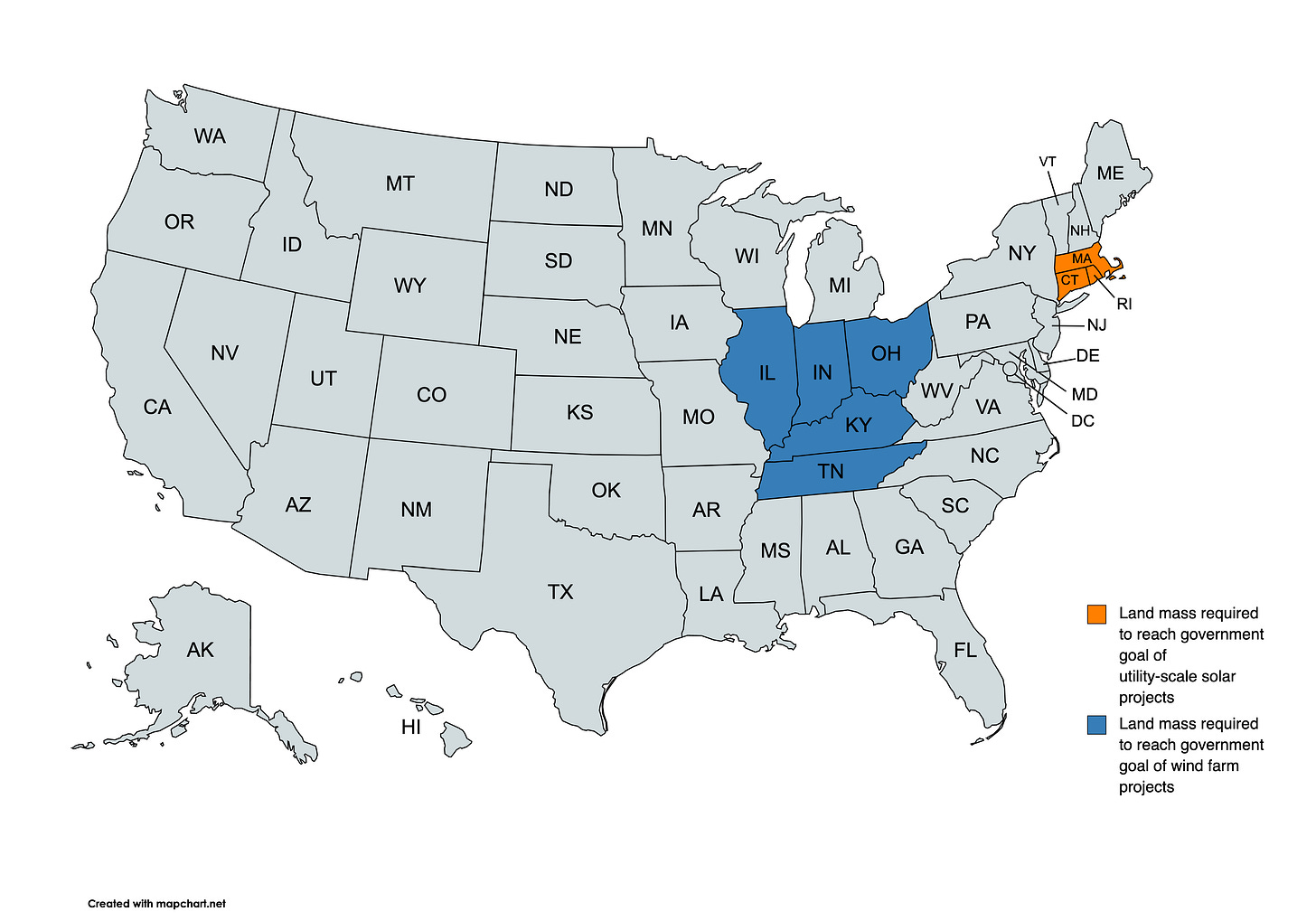Ill winds: Why green power is not such a breeze
Exploring the battle to use wind to offset conventional power generation.
You’ve heard of Big Tobacco, Big Oil, and Big Pharma. What about Big Wind?
Score yourself a point if your Collapse of Civilization Bingo card included: “Using traditional Big cartel tactics to obfuscate the truth and stretch the boundaries of reality in the name of pushing a green agenda.”
Frankly, we’ve made it all too easy for Big Wind and Big Solar, given the state of our unsuspecting, ill-informed, brainwashed minds thanks to mainstream media and other handmaidens of lies and fearmongering.
Our friends over at the Doomberg Substack laid bare the utter lunacy of the quixotic battle to use wind to offset conventional power generation. So beautifully succinct is the conundrum they lay out that we present it here in its entirety for your consideration:
“… the fundamental challenge plaguing wind technology: low energy density. Wind is dispersed and to harvest economically significant amounts of energy from it with any semblance of efficiency requires huge plastic composite blades that are designed to be both lightweight and exceptionally strong. The forces and material science challenges involved are substantial. Offshore wind blades now exceed 100 meters in length, and their tip speeds can surpass an incredible 200 miles per hour. The blades convert kinetic energy into rotational energy, which is then usually fed into a gearbox, which increases the rotational rotor speed. A generator is then used to produce electricity. Electrical, mechanical, and blade failures are common and expensive, as are the myriad ongoing servicing activities needed to maintain smooth operation. Confronting these fundamental limits of physics is challenging.”
Challenging is an understatement. What any keen-eyed observer can see with staggering clarity is that the attempted transition to a 100 percent green energy system was engineered by a bunch of amateurs. Worse, these amateurs have a double whammy of misplaced conviction and unlimited access to the public purse.
In the sleepy West Texas town of Sweetwater lies a 30-acre wind turbine graveyard. There, the stress-fractured remains of blades no longer able to handle the unimaginable pressures of spinning at supercar speeds, hundreds of feet in the air, now sprawl uselessly in the sun. Well, they are maybe not entirely useless, since they do produce an ideal breeding ground for rattlesnakes, vermin, and pests.
How did this come to be? Texas Monthly magazine — in a short exposé on the Sweetwater boneyard — explains:
The Sweetwater piles are also at least partly the indirect result of a rule clarification the Internal Revenue Service issued in 2016. Before then, a wind farm could collect valuable federal tax credits for only its first ten years of operation. But the IRS determined that it would restart the clock on the credits if a wind farm “repowered” its turbines—replacing most of their equipment with newer parts. So, despite the expected two-decade lifespan for turbine blades, wind farms across Texas and other states began replacing many that remained in good shape years early.
Of course, there are plenty of wasted resources all along any food chain… But honestly, did no one think about what to do with all the consumables required to keep these massive turbines running? This is a staggering omission in planning, execution, and regulation. The real irony is how much conventional energy is required to manufacture, transport, install, and maintain these 'green' power sources. The dissonance is all a bit sickening.
Still, it would appear that America's leftists, greens, and green leftists are hellbent on using as much public money and resources as possible to install as many wind turbines and solar panels as possible before turning off the spigots on conventional energy sources. Interestingly, it won't take that much land, either. That's if you 'trust the science' and believe official government calculations.
Real Clear Investigations reports:
The Department of Energy’s official line — echoed by many environmental activists and academics — suggests the vast array of solar panels and wind turbines required to meet the goal of “100% clean electricity” by 2035 will require “less than one-half of one percent of the contiguous U.S. land area.” That means something on the order of 15,000 square miles of the lower 48 states' roughly 3 million square miles.
There's only one problem. That's not even remotely true.
Real Clear found the actual number for wind farm land usage alone is closer to nine times higher: 134,000 square miles. And, that's not accounting for all the associated ancillary land needs: transmission towers, maintenance stations, charging stations, and so forth. The article quotes Princeton University professor, Jesse Jenkins, who estimates that reaching the goals set forth by the government could “...ultimately require utility-scale solar projects that cover the size of Massachusetts, Rhode Island, and Connecticut combined, and wind farms that span an area equal to that of Illinois, Indiana, Ohio, Kentucky, and Tennessee.”
Lie. Obfuscate. Stretch the truth. Like their siblings, Big Wind and Big Solar are doing everything they can in the name of a pointed, nihilistic agenda. The attitude is simply: 'Who cares if people don't know the full truth — we're saving the planet. We know what's best.'
There will be few, if any, stretches of horizon in America or elsewhere that won't have some spinning turbine or large transmission tower if we stay on the diabolical 'Net Zero' path our Jacobin overlords envision. But if we've learned anything thus far, the reckoning will be most painful. It always is.




